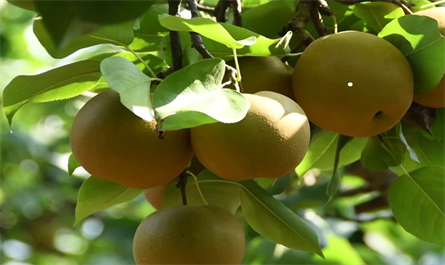Application of plant growth regulators on fruit trees - Pear

1. Improve fruit setting rate and enhance plant growth
DA-6
Spray D once with 8-15 mg/L liquid at the beginning of flowering, after fruit setting, and during fruit expansion. It can preserve flowers and fruits, increase fruit setting rate, make fruits uniform in size, good in color, sweet in taste and increase yield.
Gibberellic acid
Spraying Gibberellic acid 20-50mg/L during the budding or blooming stages of pear trees can increase the fruit setting rate of pear trees and increase the yield of pear trees. Note when using: When spraying Gibberellic acid on pear trees, the concentration should be adjusted according to the variety.
Compound sodium nitrophenolate(Atonik)
Spray 6 mg/L liquid once each on pear trees after flower fall, in the young fruit stage, and in the early stage of fruit expansion. It can increase the fruit setting rate by 6%-25%, increase the yield by 18%-20%, and increase the single fruit weight by about 15%. Soluble solids The number of fruits increased by about 1%, the first-level fruit increased by about 60%, and the diseased fruit rate decreased by 65%.
Ethephon
Spraying flowers with Ethephon during the blooming period can significantly increase the fruit setting rate.
2. Inhibit the growth of new shoots
Shortly after full flowering, spray 500mg/L chlormequat twice (at an interval of 14 days), or spray 1000mg/L once to control the growth of new shoots. Increase flower volume and fruiting in the second year.
Note when using: The appropriate concentration should be determine base on experiments based on local pear tree species; it can be mixed with butyric acid hydrazide to improve the effect of controlling shoots and increasing flowers, but cannot be mixed with Gibberellic acid and auxin.
Paclobutrazol (Paclo)
The dosage of Paclobutrazol (Paclo) is 1-2g/m⊃2 in late April; it is apply in a circular trench with a depth of 15-30cm in the
rhizosphere of pear trees, which can inhibit the growth of new shoots and increase the fruit setting rate and yield; or in May Applying 2000-3000mg/L liquid to scraped pear trees in the middle of the year can inhibit the growth of branch tips, promote flower bud differentiation and increase the fruit setting rate; make young and vigorous pear trees bloom and bear fruit early. Spraying 500mg/L Paclobutrazol (Paclo) before growing is also effective in suppressing shoots and promoting flowering.
Ethephon
sprays 500-2000mg/L ethephon on the leaves about 20 days after the pear tree blooms and when the new shoots extend to 30cm, which can significantly inhibit the growth of the new shoots for 60 days.
Compound sodium nitrophenolate (Atonik)
spray with 3-4mg/L solution after new shoots appear. Spray 2-3 times from 20 days before flowering to just before flowering. Spray 1-2 times after fruiting. Inject 3mg/L during fertilization and watering can promote germination, help fertilization, promote fruiting and fruit enlargement. Continuous use can effectively enhance and restore tree vigor, inhibit decline, and have a good effect on product quality and taste.
3. Thinning flowers and fruits
Naphthalene acetic acid(NAA)
Spraying a certain concentration of Naphthalene acetic acid (NAA) can thin flowers and fruits
4. Expand fruits and prevent pre-harvest cracking and fruit drop
Naphthalene acetic acid(NAA)
Spray 20-40mg/L Naphthalene acetic acid (NAA) before harvesting and before fruit drop is about to occur, and the anti-drop effect is more significant. The maintenance time of the drug effect is 10 days when the temperature is higher than 25℃, and it can be as long as 15-25 days at 20-25℃. Naphthalene acetic acid (NAA) treatment has the disadvantage of softening the fruit, so it is ideal to combine it with calcium preparations.
Cytokinin
The fruit shape of pears is variable. Applying 300mg/L cytokinin once each in the bud stage, flowering stage and young fruit stage of pears can increase the yield rate of fruits produce by flowers in the sixth sequence from 32.6% to 86.8%, which is the same as in the first sequence. There was no significant difference in the rate of naturally formed ducklings in fruits 88.0%.
Ethephon
It has the effect of promoting fruit ripening and enlargement, and improving economic and social benefits.
Paclobutrazol (Paclo)
Spraying 600 mg/L paclobutrazol on Korla fragrant pear during the flower bud dew stage can reduce the number of terminal fruits from 83.8% to 87%, the fruit shape index from 1.25 to 1.05, and most fruits change from spindle shape to wide ovate, with a broad Application prospects.
RECENT POSTS
Featured News



